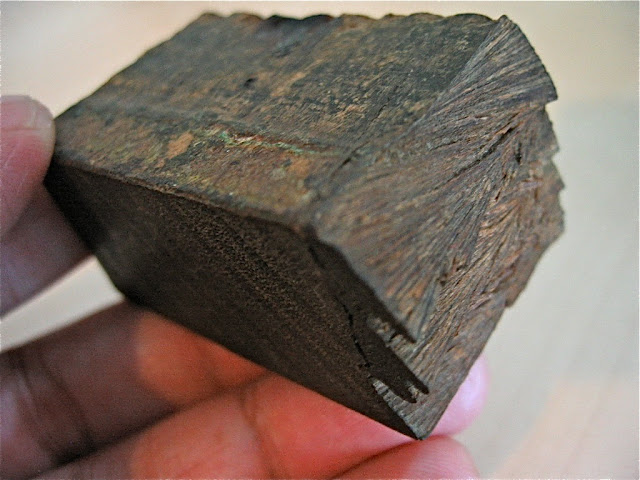In the old days, the shaft inside the tube was bronze coated and run against a longitudinal bearing, which, when I was serving my time on the Doulos, still retains its narrow strips of a very hard-wearing wood known as “lignum vitae.” Lignum vitae is hard and durable, and is also the densest wood traded; it will easily sink in water. The belaying pins and dead-eyes aboard the USS Constitution and many other sailing ships were made from lignum vitae. Due to its density and natural oils, they rarely need replacement, despite the severity of typical marine weathering conditions.
provided by www.ssmaritime.net
Pictured above, the propeller shaft tunnel (Medina's original shaft ~ see earlier post) runs through here. If, looking through during a voyage, that's the sea outside!
Commonly used in ship's propeller stern-tube bearings, due to its self-lubricating qualities, until the 1960s with the introduction of sealed white metal bearings.
It was, during our annual dry dock in 1991, Hong Kong; other than the general maintenance and external upkeep of the physical aspect of the ship, several of the ship's spaces underwent a 'not-so-small' refurbishing projects. Deep down in the belly of the ship were our engineers and engine crew, soaked in engine oil and blackened complexion, worked tirelessly on the ship's machinery and often in close and confined spaces.
One of the job was to remove the propeller shaft, and the propeller together, with crews working on the inside and dock workers, from the outside. As explained earlier, the stern tube where the propeller shaft sits, is made of wood. A remnant of a technology which dates back to the steamship era.
2nd Mate Steve Baker walked up to me and spoke about what the guys down below were doing and showed me this piece of wood that had come off (or while they were servicing the shaft) from the wooden bearing. He left it with me. This piece of history is in my hands now. I don't know whether the others have kept pieces of it or not, that I'm uncertain.
It is rock-hard!! It feels like....yeah, a rock! The weight and density of the wood is impressive. Lignum-vitae is the heartwood of the genus Guaiacum. At a hardness of 4,500 lbs. it is one of the world’s hardest woods (three times as hard as oak). In the dry state.
Other uses include Hydro bearings and Saw blocks. Other findings include some of the memorable times when the MV Doulos sailed as the MS Franca C. You wouldn't expect to find it in the most 'secretive' but obvious places on the ship. Yet, that is what the discovery is all about. It's like walking into a 'time machine', peering into its treasured past. Again I say "What a privilege to have sailed on her." Don't miss out on my posts, more to come.
 |
| 'Me' standing beside our removed propeller for servicing. Dry dock Hong Kong 1991. |





I think the common name is Pockenholz, at least in Europe, and altough it's very hard, it's not that difficult to work with carving tools or a file as well as sandpaper. I would say that it isn't very different from ebenholz. It is very waxy and I suppose it's why it was used around the shaft since it needs no greasing. I have some pieces as well, but taken from hold 1. My dad was given some from Johannes when they visited me in Phuket. I made a mini knife with a handle from pockenholz and a sheat from raindeer antler, but I lost it. It was about 3 cm and I had it around my neck as a neckless.
ReplyDeleteDaniel
Hello, I found your artical very interesting considering my business is www.lignum-vitae-bearings.com As you may know we still supply stern tube bearings for many older ships but recently had an order for lignum vitae by an asian shipbuilder building an 8,000 ton cement carrier in dirty silty water in indonesia. The owner has used many different composite plastics but all fail prematurly in the dirty water.
ReplyDeleteThanks for visiting my site. Where do you get your supply of 'lignum-vitae'? They do possess qualities which are non-present in man-made materials.
ReplyDelete